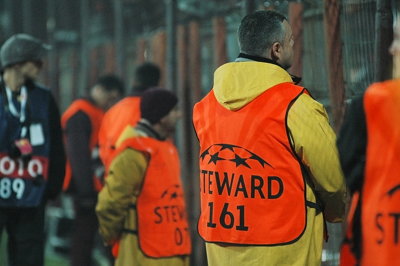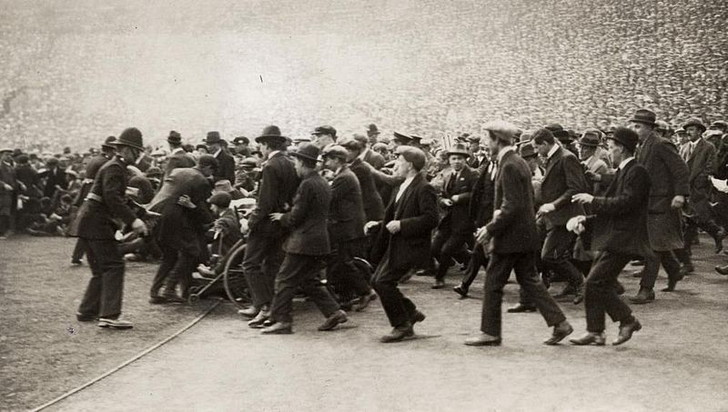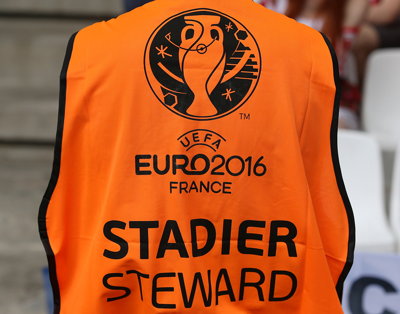Most football fans who attend grounds regularly won’t notice certain parts of the experience because they just become background noise. How often do the ball boys get a mention, for example? Other than when one grabbed the ball and gave it to Trent Alexander-Arnold for him to cross the ball and allow Divock Origi to score when Liverpool beat Barcelona 4-0 in the second-leg of the Champions League semi-final in 2019, it’s difficult to remember one not just being part of the furniture. It’s a similar story for stewards, who are a vital part of the fans’ match-going experience and yet who barely get a second thought on days when everything goes as smoothly as it should. It’s a good thing that we don’t know about them, of course, given that if we are noticing them then it almost certainly means that something has gone wrong and they’re having to step in to usher supporters to safety. Whilst they’re best being invisible, therefore, it’s still interesting to think about what they do.
Bạn đang xem: Stadium Stewards
A Brief History Of Stewarding
The White Horse final at Wembley in 1923 when 300,000 people tried to enter the stadium
The idea of needing people to be responsible for crowd safety can actually be tracked back to the opening of the original Wembley Stadium in 1923. It opened just four days before the FA Cup final that year and the Football Association had grossly under-estimated just how popular the game would be, failing to supply tickets as a means of entry. Instead, it was something of a free-for-all, with huge numbers of people filing through the 104 turnstiles to watch the match. Estimates of how many people actually turned up at Wembley range from around 240,000 to more than 300,000, with about 60,000 more locked outside. Regardless of the actual amount, it was far in excess of the 127,000 capacity.
It was thought that the match might not take place until a mounted policeman on the back of a white horse named Billy did enough to force the crowd off the pitch. It has forever been known as the White Horse Final since, with an inquiry into what happened resulting in the publication of the Shortt Report. Organisation of the match came in for criticism not only from the press but from parliament, with many believing that hundreds could have died if they hadn’t been able to get onto the pitch. Some felt that football stadiums should have to get licenses, whilst those high up in football stated a desire for matches to take place ‘under conditions which will promote the public safety’.
Between the white horse pushing people back and the allegations that the crowd calmed when the King appeared, the match began to take on a reputation as being a symbol of how well-behaved British crowds were rather than a sign of a need for reform in terms of crowd safety. Regardless, it is now seen as a moment people look back on as part of the need for safety officials.
Self-Regulation Comes To An End

Xem thêm : The Best 3 Back Formations in Soccer
For most of football’s existence, crowds were left to regulate themselves. There was little interference from clubs themselves or from the authorities, and blind eyes were turned to any moments of discomfort. This all changed in 1971 when a crush at Ibrox Park in Glasgow led to the deaths of 66 people. It was the fourth time that a crushing incident had taken place on the stairwell there and not the first time that people had died. Yet the sheer number of people that died this time meant that the authorities had no choice but to sit up and take notice, and in 1975 the Conservatives introduced the Safety at Sports Grounds Act.
The Act only applied to clubs in the English top-flight and the Scottish Premier Division, largely because it was feared that smaller clubs would go out of existence if they had to meet the criteria established. Something had to be done, though, especially as hooliganism was becoming more and more common.
The Green Guide

Two years after the disaster at Ibrox and before the Safety at Sports Grounds Act was introduced, the first Green Guide was published. It was part of the response to the report that Lord Wheatley wrote after Ibrox. Officially entitled the Guide to Safety at Sports Grounds, it is colloquially known as the Green Guide.
During the 1970s and 1980s, crowd control was seen as being akin to a military operation. Police forces were used and an emphasis was placed on public order and crowd control. The police numbers were there ‘at the expense of safety and comfort’, according to the Football Safety Officer’s Association. The 1985 Bradford Fire should have seen a change in attitudes towards the controlling of football crowds, especially as that was the same year that the Heysel Stadium tragedy occurred. Yet sadly it took until the Hillsborough Disaster in 1989 for a desire to properly control football crowds to come into place.
The Taylor Report in the wake of the tragedy that occurred in Sheffield is widely seen as a watershed moment for football. As well as encouraging the switch to all-seater stadia, there was also a push for more of a safety culture within clubs and the need for adequate ‘safety management systems’. It also led to the establishment of the Football Licensing Authority. The nature of this organization changed in 2011 to become the Sports Ground Safety Authority, which was made into an independent body in 2014. They have four key objectives, the first of which states that it will use ‘guidance, assistance, and monitoring’ to make sure that local authorities perform their jobs correctly for supporters.
Xem thêm : 14 Best Ways To Prepare For a Soccer Game
It is the Green Guide that dictates approaches to spectator safety. It is updated on a regular basis, and the SGSA speaks with various groups and organizations to ensure that it is as up-to-date and all-encompassing as possible. It is designed to reflect the trends in technology, behavior, and communication.
Stewards and police will have a meeting 3 hours before a match gets underway, with gates opening 2 hours before kickoff. The meeting is to ensure that everyone knows what to expect from the day and any things that they’ll need to look out for. Stewards will often then help to clear up the stands after the full-time whistle.
How Do You Become A Stadium Steward?
The precise information on this topic will change all the time, so make sure that you do your research if you’re hoping to become a stadium steward. That being said, there are a number of evergreen factors that we can tell you about here. The first port of call is the websites of local football clubs, with many offering stewarding positions there.
Each club will have different requirements, with stewards expected to gain their NVQ Level 2 Spectator Control qualification whilst working. The fact that stewards are expected to work towards the qualification rather than have it before they even start work means that it’s not something that you’ll need to have before applying for a job in most instances.
At the time of writing, there are no formal qualifications needed for someone to become a steward, and many football clubs outsource the work to external companies. This means that in order to become a steward, you might need to pass said company’s own requirements that will vary from business to business.
FAQs
Q: Do stewards require any formal qualifications?
A: At present, there are no specific formal qualifications required to become a steward. However, stewards are expected to work towards gaining their NVQ Level 2 Spectator Control qualification while on the job.
Q: How can I find stewarding positions at football clubs?
A: The best way to find stewarding positions at football clubs is to visit the websites of local clubs. Many clubs offer stewarding opportunities, and each club may have different requirements and application processes.
Q: Can external companies provide stewarding services for football clubs?
A: Yes, many football clubs outsource their stewarding services to external companies. If you wish to become a steward, you may need to meet the specific requirements set by the external company responsible for providing stewarding services for the club.
Conclusion
Stewards play a crucial role in ensuring the safety and enjoyment of football fans during matches. While they often go unnoticed when everything runs smoothly, they are relied upon to step in and take action during emergencies. The history of stewarding highlights the importance of crowd safety and the evolution of regulations to protect spectators. Aspiring stewards can explore opportunities through local football clubs, although specific requirements may vary. By prioritizing spectator safety, stewards contribute to the overall positive experience of attending live matches.
Nguồn: https://movin993.com
Danh mục: Tin tức








